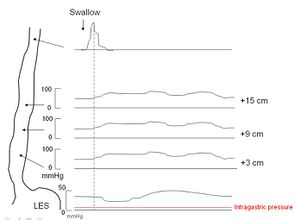We need you! Join our contributor community and become a WikEM editor through our open and transparent promotion process.
Achalasia
From WikEM
Contents
Background
- Inability of LES to relax and loss of normal peristalsis [1]
Clinical Features
- Dysphagia
- Regurgitation
- Chest pain
- Esophageal spasm can be eight, crushing retrosternal much like ACS
Differential Diagnosis
- Ingested foreign body
- Esophageal carcinoma - dysphagia predominantly for solid foods during initial stages
- Reflux esophagitis - dysphagia results from inflammatory swelling or a fibrotic stricture
- Pseudoachalasia - underlying malignancy mimics achalasia
- Connective tissue disorders - e.g. systemic sclerosis
- Esophageal spasm - chest pain a predominant feature
Evaluation
- Upper GI
- Esophageal dilatation
- Birds beak sign
- Esophageal Manometry
Management
- Trial of antispasmodic for Esophageal Spasm
- Nifedipine
- Surgical intervention
- Baloon dilatation
- Botulinum toxin injection [2]
- Myomectomy
- Consider gastrostomy for frail and older patients
- Patients need to eat upright at all times.
- Treatment may improve dysphagia, but there is no cure and swallowing never completely normalizes
Disposition
See Also
External Links
References
- ↑ Krill JT, Naik RD, Vaezi MF. Clinical management of achalasia: current state of the art. Clin Exp Gastroenterol. 2016 Apr 4;9:71-82.
- ↑ Nassri A, Ramzan Z. Pharmacotherapy for the management of achalasia: Current status, challenges and future directions. World J Gastrointest Pharmacol Ther. 2015 Nov 6;6(4):145-55.


